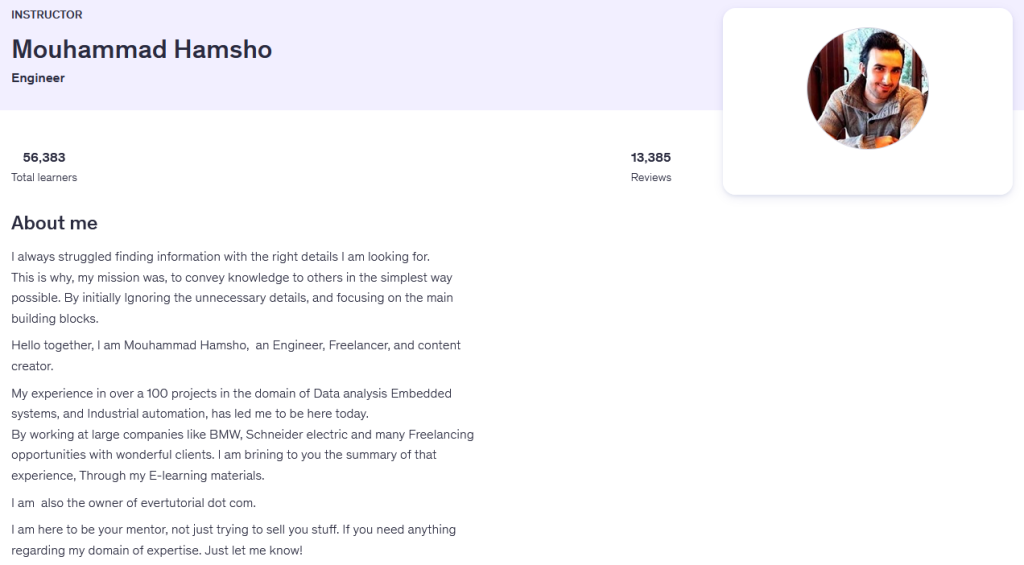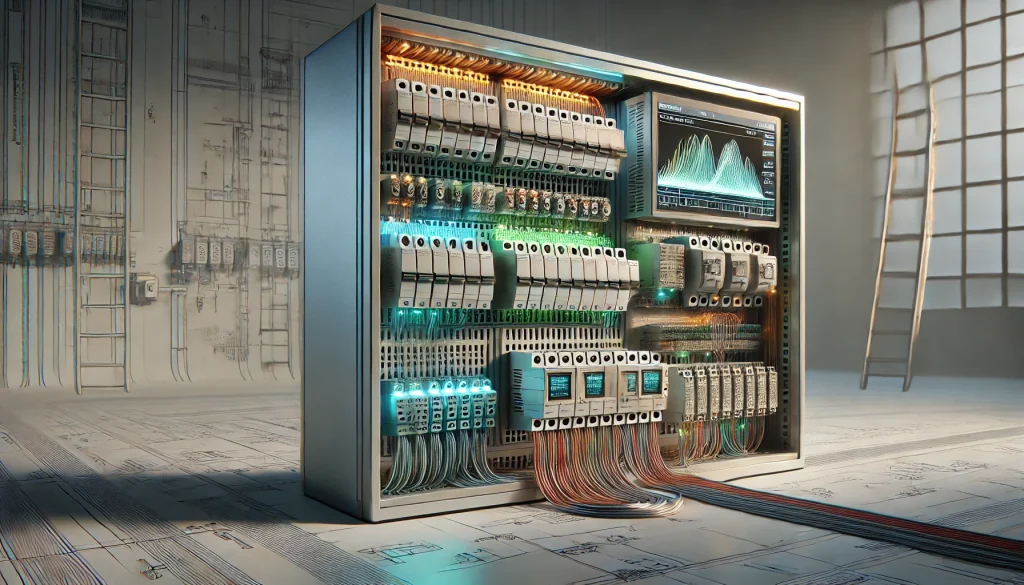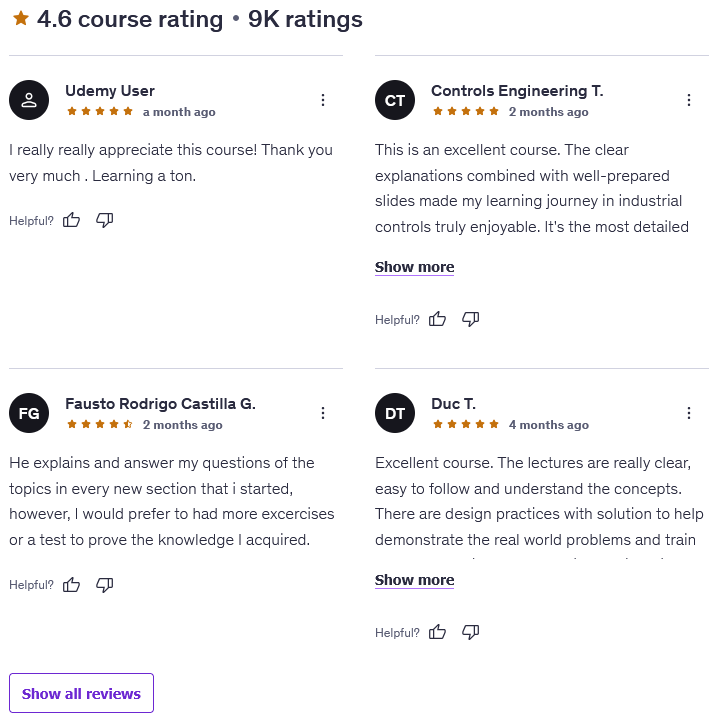If you’ve ever looked at a factory floor and wondered how all those machines talk to each other, From Wire to PLC, A Bootcamp in Industrial Automation is the course that pulls back the curtain. It takes you from zero experience to building full automation projects—starting from the literal wires and ending with fully programmed PLCs and HMIs.
What’s great is that you don’t need to own any fancy hardware or equipment. Everything is done through free software simulations, so you can learn, tinker, and build right from your laptop. Whether you’re an engineering student, a technician, or just someone fascinated by how automated systems come together, this course gives you a real-world sense of how industrial automation actually works.
Instructor Reputation
When you first enroll in From Wire to PLC, A Bootcamp in Industrial Automation, you can immediately sense that it was built by someone who’s actually been in the trenches of real engineering projects—not just someone rehashing textbook theory. That someone is Mouhammad Hamsho, an engineer and freelancer whose resume reads like a crash course in industrial experience. He’s worked on more than 100 projects, spanning fields like embedded systems, data analysis, and full-scale industrial automation. His time at companies such as BMW and Schneider Electric gives him the kind of insight you rarely find in online instructors.

But what really makes Hamsho stand out isn’t just his experience—it’s how he teaches. He has a knack for taking dense, intimidating topics like PLC programming and control circuit design and breaking them down into something you can actually digest. His philosophy is simple: strip away unnecessary complexity and focus on the “core building blocks” that help learners truly understand what’s going on. You can tell that his goal isn’t to sound smart—it’s to make you smart.
Students consistently highlight his teaching style in their reviews. Many mention that he’s incredibly responsive to questions, going above and beyond to explain tricky points in the discussion forums. One learner even mentioned that Hamsho replied personally to help clarify a design problem they were stuck on, which says a lot about his dedication. That level of mentorship turns what could’ve been a dry online course into a surprisingly interactive learning experience.
His approach combines clarity, patience, and passion. You get the sense that he genuinely enjoys seeing students make progress—especially those who are starting from scratch. And that’s what makes him such a strong instructor for this topic: industrial automation can be overwhelming, but Hamsho’s delivery makes it feel accessible.
With a 4.6-star instructor rating, 13,000+ reviews, and over 56,000 students across his 11 courses, it’s safe to say he’s built a strong reputation in the online engineering education space. He’s not just an instructor—he’s a practitioner sharing years of hands-on experience in a format that’s practical, structured, and surprisingly fun to follow.
Course Structure
The structure of From Wire to PLC, A Bootcamp in Industrial Automation is one of its strongest points—it’s designed to take you from “What even is a PLC?” to “I can design an entire automation system myself.” You don’t just jump into programming right away; the course carefully builds your foundation first.

It begins with basic electrical concepts and components—you’ll learn how current flows, what relays and contactors do, and why protection devices matter. Then it gradually transitions into real-world control circuits, where you’ll start to see how these basic elements come together to create automation logic in factories and machines.
From there, things ramp up. You dive into motor control design, sensor integration, and cable sizing—the kind of stuff engineers do daily in the field. By the time you reach the PLC programming sections, you’ve already developed a solid mental model of how everything connects in a real electrical panel.
The programming part is impressively comprehensive. Most courses focus on just one language, but this one gives you a full tour of the major PLC programming paradigms:
- Ladder Diagram (LD) — the visual logic flow that most technicians start with.
- Structured Text (ST) — for those who prefer code-like logic.
- Functional Blocks (FB) and Continuous Flow Chart (CFC) — advanced methods used in modern industrial systems.
And it’s not just theory—you’ll actually design and simulate each one. Every topic comes with exercises and design problems so you’re constantly applying what you learn. The instructor even included troubleshooting modules and sections on HMI (Human-Machine Interface) design, which is rare in beginner-level automation courses. You’ll get to see how to create animated dashboards that visualize your PLC logic—something that feels like magic the first time you see your simulation come alive.
What ties everything together is how practically sequenced the lessons are. The course follows a true A to Z structure:
- Learn the concepts.
- Design circuits and panels.
- Program the logic.
- Simulate and visualize your full project.
By the time you reach the final two compilation projects, you’re not just following instructions anymore—you’re designing like a real engineer. You’ll calculate cable sizes, select proper protection devices, draft schematics in CAD, program your PLC logic, and then integrate your HMI visualization. It’s an incredibly rewarding process that mirrors how professionals actually build automation systems.
Another nice touch is that everything is done with free software—so you don’t have to worry about expensive licenses or equipment. The course updates over the years have also added new content like Allen Bradley training, classic control simulation, and web/phone-based visualization, showing that it’s being maintained and improved for current learners.
Overall, the structure feels like a well-planned bootcamp: clear, progressive, and full of real-world application. By the end, you’ll have walked through every step of designing a working automation system—from the wire diagrams to the logic that makes machines move.
Content Quality
The content in From Wire to PLC, A Bootcamp in Industrial Automation feels like it’s been crafted by someone who actually understands how people learn complex technical skills. You can tell that this isn’t a course put together to chase trends—it’s a well-thought-out program designed to build both your confidence and competence in automation engineering.

What stands out immediately is how comprehensive the curriculum is. It doesn’t just show you how to program a PLC and call it a day. Instead, it takes you through the entire process of designing an automation system—starting from electrical fundamentals and ending with full simulation of industrial control panels and HMIs. The range of topics covered is massive: you’ll work through motor control, sensors, electrical protection, wiring design, PLC programming in multiple languages, and even visualization interfaces. It’s the kind of course that gives you both the technical know-how and the engineering mindset to actually solve problems in the real world.
Every concept is reinforced with hands-on exercises and design challenges, which is where the course really shines. You’re not just watching tutorials—you’re doing the work. Each new section builds naturally on the last, creating a smooth learning curve that keeps you engaged. By the time you reach the end, you’re not only comfortable with the tools but also with the logic behind them. The included projects help you “think like an engineer,” which is exactly what most beginners need before stepping into professional environments.
Another huge strength is how approachable the explanations are. Technical topics like ladder logic, structured text, and functional blocks can easily overwhelm new learners, but the instructor takes time to simplify them without dumbing things down. There’s a good mix of visual explanations, diagrams, and real-world analogies, making even the densest parts of the course feel digestible. It’s this clarity that keeps students motivated through the longer technical sections.
On the production side, the course materials are clean, the pacing is consistent, and the instructor’s voice and slides are easy to follow. It’s not flashy, but it’s effective—clearly organized and free from distractions. The course has also been actively updated over time, adding new modules on Allen Bradley training, classic control simulation, and web-based visualization, so you know the content isn’t static or outdated.
The only real area where some students wish for more is in interactive assessments—a few mentioned they’d love more quizzes or tests to check progress. But even without that, the abundance of exercises and real-life examples does a great job of reinforcing what you learn.
In short, the content quality here is top-tier for a practical engineering course. It’s complete, relevant, and deeply educational. By the time you finish, you won’t just understand how automation works—you’ll actually feel capable of designing your own systems from scratch.
Overall Course Rating – 9.3/10
From Wire to PLC, A Bootcamp in Industrial Automation easily earns a 9.3 out of 10 in my book—and that’s not just based on student reviews, but on the overall learning experience it provides. This course doesn’t just check the boxes; it delivers a true from-the-ground-up understanding of industrial automation.

What makes this course so impressive is how it manages to balance technical depth with real-world practicality. You start with the absolute basics—wires, circuits, and fundamental electrical concepts—and end up designing entire automation projects complete with PLC logic, HMIs, and system simulations. The progression feels organic. It doesn’t skip steps, and every section feels like it has a purpose. You’re not just memorizing diagrams—you’re building intuition about how automation systems actually function.
The inclusion of multiple PLC programming languages (Ladder Diagram, Structured Text, Functional Block Diagram, and Continuous Flow Chart) adds huge value. Most courses stick to one style of programming, but this one gives you exposure to the major approaches used across industries. That flexibility means you can adapt easily when working with different PLC brands or factory setups later in your career.
Another thing that deserves praise is the attention to detail. Each section feels deliberate, from the explanations of electrical protection to the lessons on cable sizing and motor control. Even the troubleshooting modules—something most online courses skip—help you understand not just how to build automation systems, but how to fix them when things go wrong. It’s the kind of knowledge that separates a technician from an engineer.
In terms of pacing, it’s long but never dull. There’s a satisfying rhythm between theory and application—you learn, you practice, and you see immediate results in simulation. That “aha!” moment happens frequently, especially when you finally connect all the pieces in the full-scale projects at the end.
Student feedback backs this up too. Many reviewers describe it as one of the most well-structured and thorough courses on Udemy in the automation category. Some wish for more interactive testing or more real hardware examples, but they also recognize that the use of simulation software makes the learning process more accessible and cost-free—perfect for beginners who don’t yet have access to industrial equipment.
Overall, this course doesn’t just teach you what to do; it shows you how to think like an automation engineer. If your goal is to design, program, and understand real automation systems from end to end, this course delivers on that promise and then some. It’s comprehensive, thoughtfully updated, and taught by an instructor who clearly knows the field inside and out.
For anyone curious about automation—or looking to upgrade their engineering skills in a practical, hands-on way—this course stands as one of the most complete and worthwhile options you can find online today.



